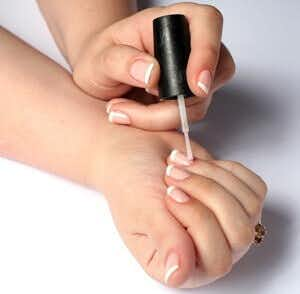
Do you bite your fingernails? Are they long and strong, or do they split or break? Fingernails draw our attention, although only a few nail conditions actually seem to interest dermatologists as indicators of underlying disease. What is the story on ridged fingernails? Part of the answer depends on which direction the ridges run. Severe illness may leave nails with horizontal ridges.
Can COVID Cause Ridged Fingernails?
Q. More than a year ago, I had a rough case of COVID. Afterwards, I noticed my thumbnails began to grow in oddly. They developed deep dips and raises across the nail, like waves in the sea.
It’s been 14 months, and my nails are still half wavy, half normal. Was the cause COVID?
A. It certainly sounds like you have a case of COVID nails. Illness, especially with a fever or microvascular involvement, can result in horizontal ridges across the nails called Beau’s lines.
You are not the only person to have noticed such changes following COVID. Doctors have suggested that they may help serve as diagnostic clues (Skin Appendage Disorders, Aug. 17, 2021).
The good news is that your nails are already starting to grow out normally. Nails grow slowly, so you will probably have to be patient. However, your COVID nails should eventually disappear. You may want to mention this the next time you see your healthcare provider.
Vertically Ridged Fingernails:
Q. I have vertical ridges on almost all my fingernails. Do you know what causes this? Is there anything I could do to improve it?
A. Although they are annoying, vertical (longitudinal) ridges on the fingernails do not appear to be dangerous. These ridges (known medically as onychorrhexis) are frequently attributed to aging. (Horizontal ridges, as described above, are quite another matter. You should bring them to the attention of your health care provider. They might simply indicate a previous nail injury, but occasionally they signal a health problem such as heart disease, infection or diabetes.)
Sometimes vertically ridged nails are also brittle. Anemia and atherosclerosis sometimes cause brittle, ridged fingernails (Canadian Family Physician, Feb., 2011).
Do You Need Supplements?
You should ask your doctor if you need supplements of iron or B vitamins to correct anemia. A few small studies have suggested that taking biotin (2.5 mg/day) can help correct ridging and fragility (Journal of Drugs in Dermatology, Aug.,2007).
One reader reported:
“A dermatologist told me to take biotin for my nails when they were splitting and cracking. I started taking a daily supplement of biotin and my nails improved greatly within three months. My son, who is a pharmacist, recommended a product containing biotin, calcium and phosphorus; my nails are strong and ridge-free.”
Other common-sense approaches include protecting the nails from prolonged exposure to water, detergent and household chemicals. How? Wear waterproof gloves when washing dishes or doing chores, preferable with cotton glove liners. This may not change the ridging at all, but it may help reduce brittleness.
Other Causes of Fingernail Ridges:
We’ve already mentioned that injury or infection that interferes with nail growth could result in a horizontal ridge, or sometimes more than one. Some systemic diseases can produce vertical ridges. For example, when the immune system attacks the nails as part of lichen planus, it frequently shows up as nail ridges (Indian Journal of Dermatology, Venereology, and Leprology, Oct. 26, 2023). Ridged or abnormal fingernails may also point to psoriasis (Frontiers in Immunology, Jan. 20, 2022). Sometimes the dermatologist prescribes a topical steroid for symptom control, but treating the underlying immune system dysfunction may also be necessary.

